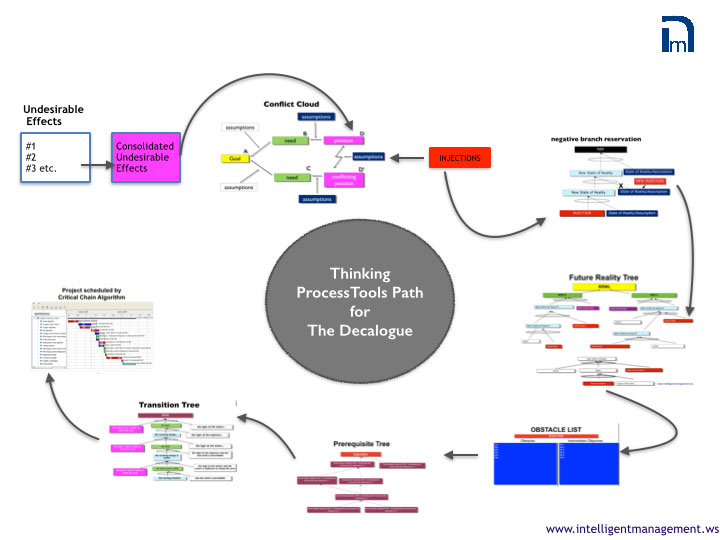 In moving away from silos towards systems, we need to understand the problems afflicting the organization in its current reality to go forward and build a robust strategy and action plan. In Part 2 of our post on building a Systemic Strategy, we illustrate the cycle of Thinking Process tools we use.
In moving away from silos towards systems, we need to understand the problems afflicting the organization in its current reality to go forward and build a robust strategy and action plan. In Part 2 of our post on building a Systemic Strategy, we illustrate the cycle of Thinking Process tools we use.
Why we need the Thinking Process Tools
Change is cognitively challenging and inertia can quickly become the constraint of an organization. Sometimes, when change is required, the pace at which knowledge is being generated is challenging, both mentally and emotionally.
The Thinking Process Tools from The Theory of Constraints allow us to identify the changes we need to make and plan those changes in a robust and systematic way. They also help us learn how to see change as not simply something to be feared, but a natural, intrinsic part of our life. When we learn how to use our intuition and intellect to implement consistent action, change is no longer a threat and a hazard; it is a continuous source of new opportunities.
The Thinking Process tools can be learned and applied with great success. Intelligent Management Inc. has been training individuals and organizations with these tools for over 15 years.The diagram below illustrates the cycle of Thinking Process Tools as they are applied to the creation and implementation of a strategy.
How the cycle works
This cycle starts by identifying the Undesirable Effects that characterize the current reality of an organization. We summarize those into one, generic Undesirable Effect (top pink box), that becomes position D in the Core Conflict cloud.This allows us to verbalize a Desired Reality, that becomes position D’ (bottom pink box).We then verbalize the needs (green boxes) that underlie positions D and D’. These needs reflect our fear of change and our desire to move forward. By addressing these needs we are able to understand the profound drivers that lead us towards complying with an undesirable reality, on the one hand, and our vision for positive change, on the other. By acknowledging and respecting these needs, we are able to derive a common and realistic goal (yellow box.)
We can move forward from the situation of blockage depicted in the Core Conflict Cloud by invalidating the assumptions between positions D and D’ with a set of Injections (solutions) – see the red box. We can then connect all the injections with a logic of sufficiency towards the goal identified using the tool called the Future Realty Tree, that maps out all the injections towards the goal. We can check the injections for negative implications with a tool called ‘Negative Branch Reservation’.
In order to create actionable steps for the Future Reality Tree, we have to acknowledge that we perceive obstacles in our way and we have to be able to overcome those obstacles. For this purpose, we build Prerequisite Trees for each injection. A Prerequisite Tree is built by first listing all the obstacles we perceive as standing in our way between where we are today and the achievement of our solutions. In order to move beyond these obstacles, we transform them into Intermediate Objectives. These are statements that, if achieved, overcome all the obstacles on our path towards achieving each injection on our Future Reality Tree. We map out the Intermediate Objectives based on prerequisites, i.e. what has to be done first in order to complete the others.
We still need a further level of detail to be able to take action and create a detailed work plan. For every Intermediate Objective, we build Transition Trees to create step-by-step actions.This level of detail allows us to create a scheduled project for every Injection.The method used for projects is the Critical Chain Project Management method, based on finite capacity scheduling.
For more information about a systemic approach for sustainable prosperity, see our new business novel+website ‘The Human Constraint’.
Inspired by real life events, this novel provides a fast-paced narrative and an online Knowledge Base of tools and insights for systemic management. Written by Angela Montgomery, PhD.






Leave a Reply